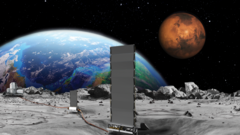The agency's recent commitment has raised concerns, especially considering recent budget cuts and the feasibility of meeting this ambitious timeline. By harnessing nuclear power—which many scientists argue is essential for continuous energy on the Moon—Nasa aims to overcome the limitations of solar power, particularly during extended lunar nights.
In response to these challenges, the acting head of Nasa urged for commercial partnerships to develop a compact reactor capable of generating 100 kilowatts. Despite the technical challenges involved in launching and deploying nuclear material safely, some experts believe that, with adequate funding and support from the Artemis program, placing reactors on the lunar surface is achievable.
Nevertheless, this surge in efforts is met with skepticism given recent budget reductions, which have impacted other significant projects. The underlying motivations behind these plans also reflect a competitive spirit reminiscent of earlier space explorations, prompting concerns over national interests overshadowing scientific endeavors. As the US navigates this complex situation, the question of lunar ownership and the establishment of safety zones adds another layer of complexity to the evolving landscape of international space law.
Dr. Simeon Barber highlights the risk of establishing territorial claims through nuclear installations, stressing that these developments could reinforce divisions in human exploration of the Moon.
The timeline for Nasa's Artemis 3 mission, which aims to return astronauts to the Moon in 2027, adds urgency to these plans, even as uncertainties loom regarding funding and logistical challenges. Ultimately, while the potential for nuclear reactors on the Moon marks an exciting frontier in space exploration, the practical realities and geopolitical implications warrant careful consideration.
The exploration of the Moon's potential involves more than just technological advancements; it reflects an ongoing quest for humanity's place in the cosmos.
In response to these challenges, the acting head of Nasa urged for commercial partnerships to develop a compact reactor capable of generating 100 kilowatts. Despite the technical challenges involved in launching and deploying nuclear material safely, some experts believe that, with adequate funding and support from the Artemis program, placing reactors on the lunar surface is achievable.
Nevertheless, this surge in efforts is met with skepticism given recent budget reductions, which have impacted other significant projects. The underlying motivations behind these plans also reflect a competitive spirit reminiscent of earlier space explorations, prompting concerns over national interests overshadowing scientific endeavors. As the US navigates this complex situation, the question of lunar ownership and the establishment of safety zones adds another layer of complexity to the evolving landscape of international space law.
Dr. Simeon Barber highlights the risk of establishing territorial claims through nuclear installations, stressing that these developments could reinforce divisions in human exploration of the Moon.
The timeline for Nasa's Artemis 3 mission, which aims to return astronauts to the Moon in 2027, adds urgency to these plans, even as uncertainties loom regarding funding and logistical challenges. Ultimately, while the potential for nuclear reactors on the Moon marks an exciting frontier in space exploration, the practical realities and geopolitical implications warrant careful consideration.
The exploration of the Moon's potential involves more than just technological advancements; it reflects an ongoing quest for humanity's place in the cosmos.

















